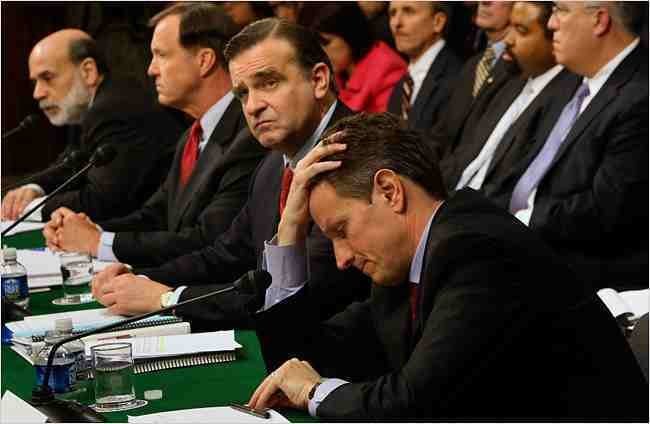
I recently spoke at a Federal Reserve conference in Chicago, on financial regulation. The keynote speaker was Ben Bernanke. Chairman Bernanke was unable to leave Washington, so he spoke live, via a giant TV screen, giving his speech a fittingly Orwellian cast.
This was the day that the results of the so called stress tests were released. Not surprisingly, Bernanke was upbeat, since restoring confidence was the whole political point of the stress-test exercise. No major bank was insolvent, and the 19 largest banks collectively needed to raise only about $75 billion in additional capital, although their losses might total as much as $599 billion. Citigroup, queen of the Zombie Banks, remarkably enough, was said to need only $5.5 billion in additional private capital. You could almost make up that paltry sum with executive bonuses.
At one point in his remarks, Bernanke, recounting just how rigorous the stress tests were, explained that "More than 150 examiners, supervisors, and economists" had conducted several weeks of examinations of the banks. That kind of let the cat out of the bag. If you do the arithmetic, that is about seven supervisors per bank, and all of the stress-tested 19 banks were hundred-billion and up outfits. When an ordinary commercial bank, say a $10 billion outfit, undergoes a far less complex routine examination of its commercial loan portfolio, it involves dozens of examiners.
So the stress test was not a set of rigorous examinations at all, but a modeling exercise using the banks' own valuations of their assets. The most serious outside observers think the hole in the banks' balance sheets is much larger than $75 billion or even the Fed's worst-case estimate of $599 billion in losses. The International Monetary Fund estimates the hole as more like 2.7 trillion dollars, and informed economists like Nouriel Roubini put the number at as much as 3.6 trillion.
Why is the Fed low-balling the problem? The hope is that by keeping the banks afloat for a few more months, and trying to entice private capital back to the table, the recovery in other parts of the economy will spill over onto the banks. But the greater likelihood is that weakened banks will continue dragging down the rest of the economy.
Despite talk of "green shoots," - economic indicators not being quite as bad as expected, and the stock market up - most of the news is still pretty grim. Unemployment was up in April by "only" 539,000 jobs. Home foreclosures keep rising, with a total of eight million projected this year. Manufacturing is dead in the water. The administration's voluntary (to the banks) mortgage relief program will address only a fraction of the problem; and 12 Senate Democrats voted with the banking industry to deny bankruptcy judges the ability to modify the terms of a mortgage as a last resort - thus killing the one proposed stick in a program that is all carrots.
I also recently spoke at a convention of industrial construction companies. These are the people who build and maintain factories, power plants, and do other heavy industrial construction. I asked a room full of hundreds of executives how many saw signs of improvement in their order books. Not a single hand went up. Then I asked how many had had projects deferred because of difficulty getting financing. About two thirds of the people in the room raised their hands.
My guess is that the Obama administration will be back next fall, asking Congress for the money and authority to do the bank rescue right, after the current policy proves inadequate to restore the banking system and the economy to health. That would mean taking the insolvent banks into receivership, deciding how much public capital was required and where to get it, and then returning the banks to private ownership. Better late than never, but it's a pity to waste six months.
Chatting with the bankers in attendance at the Fed conference, mostly bankers from the heartland of the Midwest, I encountered resentment bordering on fury at the double standard. The big Wall Street banks are getting propped up with literally trillions of dollars in aid from the Treasury and the Federal Reserve, while community bankers that stuck to their knitting and did not go in for the sub-prime swindle are suffering collateral damage. That's a pun, by the way.
Because of the huge losses to the FDIC's insurance fund, small and medium sized healthy banks are having to pay increased premiums. And while the Fed and the Treasury are being extremely gentle in letting the big money-center banks like Citi value their distressed securities with great charity and forbearance, the community banks are having their loan portfolios examined with fine-tooth combs. With regulators breathing down their necks, and fewer sure-thing businesses in a position to borrow, the community banks are being made to raise their lending standards, contributing to the vicious circle of reduced business activity and reduced credit.
Why had the administration made this perverse alliance with Wall Street, and decided to prop up large zombie banks rather than taking them into receivership and getting on with it? You could blame it on campaign finance, or you could blame it on the quirk of history that Obama, once he became the nominee, decided to hire the Wall Street-oriented Clinton economic team.
The most hopeful and elegant theory I've heard is that for now, Obama's main political project is to let the Republicans self-destruct; co-opting Wall Street (for now) is part of that game plan. He'll get around to reforming Wall Street next year. Even Roosevelt had to take things one step at a time, as public opinion moved. The Second New Deal was more radical than the first. I've often said that Obama is smarter than I am, and if he is politically shrewd enough to have come up with that strategy, hats off to him. I'm also a Red Sox fan, and anything is possible. But for the moment, it looks more like a case of political expediency and even political capture.
I could excuse all that if the Geithner-Summers-Bernanke strategy of low-balling the scale of the banks' problems and inviting speculators to bail them out actually worked. But the greater likelihood is that the economy will tread water at best for the remainder of this year, losing both precious time and political credibility in America's heartland.
Robert Kuttner is co-Editor of The American Prospect and a senior fellow at Demos. His recent book is Obama's Challenge: America's Economic Crisis and the Power of a Transformative Presidency.
